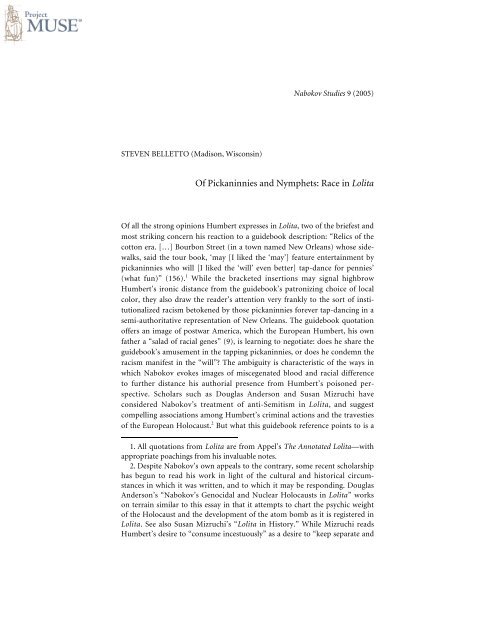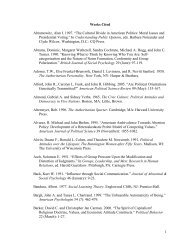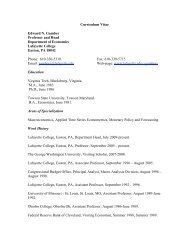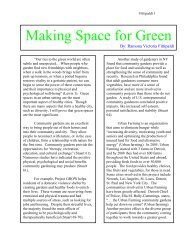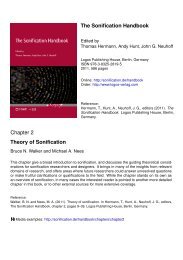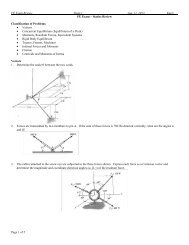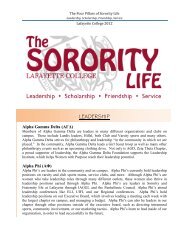Of Pickaninnies and Nymphets: Race in Lolita - Project MUSE
Of Pickaninnies and Nymphets: Race in Lolita - Project MUSE
Of Pickaninnies and Nymphets: Race in Lolita - Project MUSE
- No tags were found...
Create successful ePaper yourself
Turn your PDF publications into a flip-book with our unique Google optimized e-Paper software.
Nabokov Studies 9 (2005)STEVEN BELLETTO (Madison, Wiscons<strong>in</strong>)<strong>Of</strong> <strong>Pickan<strong>in</strong>nies</strong> <strong>and</strong> <strong>Nymphets</strong>: <strong>Race</strong> <strong>in</strong> <strong>Lolita</strong><strong>Of</strong> all the strong op<strong>in</strong>ions Humbert expresses <strong>in</strong> <strong>Lolita</strong>, two of the briefest <strong>and</strong>most strik<strong>in</strong>g concern his reaction to a guidebook description: “Relics of thecotton era. […] Bourbon Street (<strong>in</strong> a town named New Orleans) whose sidewalks,said the tour book, ‘may [I liked the ‘may’] feature enterta<strong>in</strong>ment bypickan<strong>in</strong>nies who will [I liked the ‘will’ even better] tap-dance for pennies’(what fun)” (156). 1 While the bracketed <strong>in</strong>sertions may signal highbrowHumbert’s ironic distance from the guidebook’s patroniz<strong>in</strong>g choice of localcolor, they also draw the reader’s attention very frankly to the sort of <strong>in</strong>stitutionalizedracism betokened by those pickan<strong>in</strong>nies forever tap-danc<strong>in</strong>g <strong>in</strong> asemi-authoritative representation of New Orleans. The guidebook quotationoffers an image of postwar America, which the European Humbert, his ownfather a “salad of racial genes” (9), is learn<strong>in</strong>g to negotiate: does he share theguidebook’s amusement <strong>in</strong> the tapp<strong>in</strong>g pickan<strong>in</strong>nies, or does he condemn theracism manifest <strong>in</strong> the “will”? The ambiguity is characteristic of the ways <strong>in</strong>which Nabokov evokes images of miscegenated blood <strong>and</strong> racial differenceto further distance his authorial presence from Humbert’s poisoned perspective.Scholars such as Douglas Anderson <strong>and</strong> Susan Mizruchi haveconsidered Nabokov’s treatment of anti-Semitism <strong>in</strong> <strong>Lolita</strong>, <strong>and</strong> suggestcompell<strong>in</strong>g associations among Humbert’s crim<strong>in</strong>al actions <strong>and</strong> the travestiesof the European Holocaust. 2 But what this guidebook reference po<strong>in</strong>ts to is a1. All quotations from <strong>Lolita</strong> are from Appel’s The Annotated <strong>Lolita</strong>—withappropriate poach<strong>in</strong>gs from his <strong>in</strong>valuable notes.2. Despite Nabokov’s own appeals to the contrary, some recent scholarshiphas begun to read his work <strong>in</strong> light of the cultural <strong>and</strong> historical circumstances<strong>in</strong> which it was written, <strong>and</strong> to which it may be respond<strong>in</strong>g. DouglasAnderson’s “Nabokov’s Genocidal <strong>and</strong> Nuclear Holocausts <strong>in</strong> <strong>Lolita</strong>” workson terra<strong>in</strong> similar to this essay <strong>in</strong> that it attempts to chart the psychic weightof the Holocaust <strong>and</strong> the development of the atom bomb as it is registered <strong>in</strong><strong>Lolita</strong>. See also Susan Mizruchi’s “<strong>Lolita</strong> <strong>in</strong> History.” While Mizruchi readsHumbert’s desire to “consume <strong>in</strong>cestuously” as a desire to “keep separate <strong>and</strong>
2 Nabokov Studiesparticularly American legacy of slavery (“Relics of the cotton era”) <strong>and</strong> everpresentracism, both of which become tangled with Humbert’s febrile meditationson his relationship with <strong>Lolita</strong>.Nabokov once remarked that “In home politics I am strongly anti-segregationist”(Strong Opn<strong>in</strong>ons 98); while <strong>Lolita</strong> is of course not about race perse, postwar American race relations nonetheless shape Humbert’s aesthetic,an awareness of which allows us to better appreciate the author’s own, moregenerous, aesthetic visible through his construction’s cloy<strong>in</strong>g <strong>and</strong> stridentnarrative voice. 3 Through Nabokov’s generous aesthetic of curiosity <strong>and</strong>tenderness, <strong>Lolita</strong> still has someth<strong>in</strong>g new to tell us about the ways contemporaneousracial categories were erected as slyly as Humbert’s twisted yet seductive<strong>in</strong>vention of the nymphet. Nabokov demonstrates how the creation ofsuch aesthetic categories was effected laterally, through homological associations<strong>and</strong> tacit cultural images, often so subtly that it passed for reality itself, aconfusion that for him was always a dangerous one.Although the “pickan<strong>in</strong>nies” are obvious examples of a mid-century idiomthat seems dubious at best to contemporary readers, the ways Humbert refersto race relations are <strong>in</strong> general oblique: images of idealized masters <strong>and</strong> theirslaves are bound up both <strong>in</strong> descriptions of employers <strong>and</strong> servants <strong>and</strong> <strong>in</strong>descriptions of his abusive relationship with <strong>Lolita</strong>. 4 What first becomesnoticeable for the reader is the casual bigotry of the WASPish middle-classworld <strong>in</strong>to which Humbert stumbles when seek<strong>in</strong>g a room <strong>in</strong> Ramsdale. Atrip to Hourglass Lake offers Charlotte Haze occasion to describe an offh<strong>and</strong>remark made by her friend John Farlow. About Leslie, the black servant ofpure” (635), it will be evident <strong>in</strong> the pages to follow that I th<strong>in</strong>k Humbert’sawareness of American racial difference troubles such claims to purity.3. I have <strong>in</strong> m<strong>in</strong>d here someth<strong>in</strong>g like the terms Kenneth Warren establishes<strong>in</strong> his study of race <strong>in</strong> Henry James: “racial concerns shaped James’saesthetic even when his texts were not specifically ‘about’ race <strong>in</strong> any substantiveway. This read<strong>in</strong>g of James is not meant to be comprehensive butsuggestive, an <strong>in</strong>dication of the possibilities that an attention to race mayhold for further studies of American literature” (12). As I argue <strong>in</strong> this essay,Humbert’s <strong>and</strong> Nabokov’s aesthetics are similarly shaped by racial concerns,if only partially, <strong>and</strong> I am hardly <strong>in</strong>trepid enough to pretend a comprehensiveread<strong>in</strong>g of <strong>Lolita</strong>.4. Eric Rothste<strong>in</strong> writes: “S<strong>in</strong>ce ‘<strong>Lolita</strong>’ exists only as a figment of Humbert’sfantasy life, I will call the character ‘Dolores’ throughout’” (22). Thisseems to me a just rhetorical move. I refer to Dolores when I’m talk<strong>in</strong>g aboutthe girl, <strong>Lolita</strong> when I’m talk<strong>in</strong>g about the nymphet, the figment of Humbert’simag<strong>in</strong>ation.
<strong>Race</strong> <strong>in</strong> <strong>Lolita</strong> 3“Miss Opposite”—a character so dubbed by Humbert because she lives oppositethe Haze household—Humbert relates:Charlotte remarked that Jean Farlow, <strong>in</strong> quest of rare light effects (Jeanbelonged to the old school of pa<strong>in</strong>t<strong>in</strong>g), had seen Leslie tak<strong>in</strong>g a dip “<strong>in</strong>the ebony” (as John had quipped) at five o’clock <strong>in</strong> the morn<strong>in</strong>g lastSunday […] . [Charlotte said] “He is subnormal, you see. And […] Ihave a very def<strong>in</strong>ite feel<strong>in</strong>g our Louise is <strong>in</strong> love with that moron.” (82)Like the guidebook entry Nabokov has Humbert quote verbatim, the effect ofJohn Farlow’s quip is to offer further primary evidence of the various registersof racism present <strong>in</strong> postwar America. 5 As we will see, Humbert leveragesAmerican racism, whether backh<strong>and</strong>ed or bluntly discrim<strong>in</strong>atory, to advancethe feeble argument that his pedophilic <strong>in</strong>dulgence is legitimated by thevery context <strong>in</strong> which it operates—what, Humbert implies, could be moredespicable than a culture built on clumsy categorization <strong>and</strong> <strong>in</strong>stitutionalizedsegregation?Notorious solipsist that he is, Humbert fits all the people <strong>in</strong> his life <strong>in</strong>toeasily identifiable categories—from Miss Opposite to Miss Lester <strong>and</strong> MissFabian, for him two parts of the same “Lesbian.” The difference with his useof American racial categories is that he is appropriat<strong>in</strong>g a cultural phenomenon.Whereas label<strong>in</strong>g a neighbor only by her geographical position is arelatively <strong>in</strong>nocuous quirk of Humbert’s, the tendency to abstract people <strong>in</strong>totypes accord<strong>in</strong>g to their physical attributes is endemic to the kitschy Americanaesthetic Humbert claims to shun. Because of the cultural <strong>in</strong>cl<strong>in</strong>ation toconvert images like pickan<strong>in</strong>nies <strong>in</strong>to verifiable reality—go to New Orleans<strong>and</strong> see them tapp<strong>in</strong>g—the important dist<strong>in</strong>ction between these two sortsof lump<strong>in</strong>g is that racial stereotypes <strong>in</strong> this cultural moment limit the categorizedonly to their subservient performative function. Humbert’s aesthetic,however highbrow <strong>in</strong> its allusiveness <strong>and</strong> sensual style, is thus nonethelesssimilar to the postwar poshlust aesthetic that produced <strong>and</strong> consumed theguidebook. 6 Attention to race <strong>in</strong> <strong>Lolita</strong> demonstrates, <strong>in</strong> part, that Humbert’saesthetic is more kitschy than he admits or knows, <strong>and</strong> that Nabokov’s5. Boyd cites this passage as evidence of Nabokov’s disda<strong>in</strong> for racism(242).6. Nabokov describes poshlust as an approximate synonym for kitsch. Ashe expla<strong>in</strong>ed <strong>in</strong> an <strong>in</strong>terview: “Corny trash, vulgar clichés, Philist<strong>in</strong>ism <strong>in</strong> allits phases, imitations of imitations, bogus profundities, crude, moronic <strong>and</strong>dishonest pseudo-literature—these are all obvious examples” (Strong Op<strong>in</strong>ions101). For a fuller work<strong>in</strong>g out of kitsch that pays special attention to Nabokov’stheory of poshlust, see Matei Cal<strong>in</strong>escu (225–62).
4 Nabokov Studiesaesthetic, <strong>in</strong> contrast, allows for the possibility of discreteness rather than easycerta<strong>in</strong>ty. 7John Farlow’s quip yields the first stirr<strong>in</strong>gs of the aff<strong>in</strong>ities between racialdiscrim<strong>in</strong>ation <strong>and</strong> Humbert’s dom<strong>in</strong>ation over <strong>Lolita</strong> that are developedthroughout the novel. 8 Many of these concerns come together at TheEnchanted Hunters, the surreal hotel where Humbert <strong>and</strong> Dolores firstengage <strong>in</strong> sexual relations. While register<strong>in</strong>g at The Enchanted HuntersHumbert himself becomes the object of sly anti-Semitism: the porc<strong>in</strong>e deskclerk evaluates his “features with a polite smile,” notes the Jewish-look<strong>in</strong>gname on the telegram reservation, <strong>and</strong> suavely expla<strong>in</strong>s they are all full up.Humbert responds <strong>in</strong> k<strong>in</strong>d: “‘The name,’ I said coldly, ‘is not Humberg <strong>and</strong>not Humbug, but Herbert, I mean Humbert, <strong>and</strong> any room will do’” (118). 97. David Andrews argues that Nabokov “does not believe knowledge canever be ‘complete.’ For him, truth exists as an <strong>in</strong>completely knowable th<strong>in</strong>g”(53). I see this as related to Nabokov’s <strong>in</strong>terest <strong>in</strong> curiosity <strong>and</strong> possibility,characteristics antithetical to glib categorization.8. Like John Farlow, earnest Charlotte st<strong>and</strong>s as representative of the “artymiddle class” (36), <strong>and</strong> she pronounces Leslie simply “subnormal.” Aga<strong>in</strong> thereader is left unsure whether such a statement is warranted by his mentalacuity or his sk<strong>in</strong> color. Note also that <strong>in</strong> the same scene, Charlotte also longsto replace Louise herself with a servant who would be of purest possible stock:“I would love to get hold of a real tra<strong>in</strong>ed servant maid like that German girlthe Talbots spoke of” (82).9. Appel expla<strong>in</strong>s that the phrase “NEAR CHURCHES”—which appearson The Enchanted Hunters’s note-paper—was a “discreet <strong>in</strong>dication that onlyGentiles were accepted” (435). Humbert notes that he had “the Tour Book ofthe Automobile Association” (145), <strong>and</strong> <strong>in</strong> his prison cell he still has “anatrociously crippled tour book <strong>in</strong> three volumes, almost a symbol of my torn<strong>and</strong> tattered past” (154). The three-volume tour book Humbert has is theAmerican Automobile Association’s Hotel Directory, which was divided <strong>in</strong>toNortheastern, Western, <strong>and</strong> Southeastern volumes. The 1940 edition <strong>in</strong>cludeslist<strong>in</strong>gs such as the Dixie Inn <strong>in</strong> Alex<strong>and</strong>ria Bay, New York, <strong>and</strong> the HotelWash<strong>in</strong>gton <strong>in</strong> Newburgh, New York, both of which were “convenient tochurches” (69; 79). The Arrowhead Hotel <strong>in</strong> Inlet, New York, was both “nearchurches” <strong>and</strong> boasted “restricted clientele” (75). Thus there seems to havebeen a range of code words guidebooks employed to <strong>in</strong>dicate that Jewishtravelers need not <strong>in</strong>quire with<strong>in</strong>. Humbert mentions that Dolores dem<strong>and</strong>edthe imprimatur of “Huncan D<strong>in</strong>es” (148) wherever they went. In DuncanH<strong>in</strong>es’s 1948–49 edition of Vacation Guide, he prefers the more ambiguous“For quiet, conservative people” (107, 108, 198), but also notes places “with agenerally ‘well-bred’ atmosphere” (114); <strong>and</strong> others that cater, accord<strong>in</strong>g to
<strong>Race</strong> <strong>in</strong> <strong>Lolita</strong> 5Although this encounter proves noth<strong>in</strong>g but a m<strong>in</strong>or impediment to Humbert’sstratagem, a similar <strong>in</strong>cident is reported with<strong>in</strong> pages of the commencementof Part Two’s road trip: “I shudder when recall<strong>in</strong>g that soi-distant‘high-class’ resort <strong>in</strong> a Midwestern state, which advertised ‘raid-the-icebox’midnight snacks <strong>and</strong>, <strong>in</strong>trigued by my accent, wanted to know my dead wife’s<strong>and</strong> dead mother’s maiden names” (147). Furtive discrim<strong>in</strong>ation is thus apattern on the road, <strong>and</strong> Humbert’s denunciation is doubly damn<strong>in</strong>g as heconverts “high-class” <strong>in</strong>to an epithet with his French <strong>and</strong> his scare quotes,a riposte that suggests that a truly high-class establishment, sans quotationmarks, ought to be above such petty discrim<strong>in</strong>ation. 10 The <strong>in</strong>quir<strong>in</strong>g <strong>in</strong>nkeepersshare their doubts about Humbert with Charlotte herself, whose suspicionsare rankled once he becomes a marriage prospect: “she also askedme had I not <strong>in</strong> my family a certa<strong>in</strong> strange stra<strong>in</strong>. I countered by <strong>in</strong>quir<strong>in</strong>gwhether she would still want to marry me if my father’s maternal gr<strong>and</strong>fatherhad been, say, a Turk” (74–75). 11 The possibility of Humbert’s hav<strong>in</strong>g miscegenatedblood haunts much of the novel <strong>and</strong> affects his descriptions ofDolores’s pollution, descriptions which, as we will see, aga<strong>in</strong> suggest that theracialized aesthetic <strong>in</strong>forms the novel’s larger ethical arc.Later <strong>in</strong> the novel Humbert comes to marshal the image of his own miscegenatedblood <strong>in</strong>sofar as he figures <strong>Lolita</strong> herself as polluted by it, but <strong>in</strong> thatmoment at The Enchanted Hunters, he is offended enough by the clerk’spresumptive discrim<strong>in</strong>ation to react <strong>in</strong>dignantly. In fact, once the mistakenname on the telegram is cleared up, another curious detail is offered—Humbert <strong>and</strong> Dolores’s luggage is h<strong>and</strong>led by a “hunchbacked <strong>and</strong> hoaryNegro <strong>in</strong> a uniform of sorts” (117). This bellhop leads the way to room 342as Humbert refers to him as “Uncle Tom” (118). Is this an example of the<strong>in</strong>jured Humbert, however “attractively simian” he admits to be<strong>in</strong>g (104),the management, to “ref<strong>in</strong>ed f<strong>in</strong>e folks, young <strong>and</strong> old” (115). What suchstatements “really” mean perhaps Humbert could say.10. By 1954, the number of Jews on the American travel scene was greatenough to warrant Bernard Postal <strong>and</strong> Lionel Koppman’s A Jewish Tourist’sGuide to the U.S. The po<strong>in</strong>t of this volume was not to provide a list of friendlyhotels, but rather a comprehensive account of Jewish contributions toAmerican character so that “The traveller who makes all or part of the journeymapped out <strong>in</strong> this book is sure to stub his toe on American Jewish historywherever he goes” (xii).11. Humbert himself associates his pedophilia with his be<strong>in</strong>g turn’d Turk:“In my self-made seraglio, I was a radiant <strong>and</strong> robust Turk, deliberately, <strong>in</strong>the full consciousness of his freedom, postpon<strong>in</strong>g the moment of actuallyenjoy<strong>in</strong>g the youngest <strong>and</strong> frailest of his slaves” (60).
6 Nabokov Studiesredoubl<strong>in</strong>g his efforts to enjoy the categoriz<strong>in</strong>g power of the WASPishethnic elite typified by the Hazes, the Farlows, <strong>and</strong> the management of TheEnchanted Hunters? If so, it would certa<strong>in</strong>ly go a long way <strong>in</strong> expla<strong>in</strong><strong>in</strong>g whyhe postures as a supercilious master to the black bellhop’s Uncle Tom, anaffect that would seem fitt<strong>in</strong>g <strong>in</strong>deed to those tourists who might toss theirpennies to pickan<strong>in</strong>nies. That Humbert has positioned himself as discrim<strong>in</strong>atorrather than discrim<strong>in</strong>atee is evident as Uncle Tom is reduced to asynecdochic want<strong>in</strong>g black h<strong>and</strong>: “I was tempted to place a five-dollar bill <strong>in</strong>that sepia palm, but thought the largesse might be misconstrued, so I placeda quarter” (119). Humbert’s swell<strong>in</strong>g near-beneficence is predicated uponthe bellhop’s only be<strong>in</strong>g Uncle Tom, an imag<strong>in</strong>ed type that allows him tosavor the powerful position of see<strong>in</strong>g Uncle Tom’s “sepia palm” with avision as backward-look<strong>in</strong>g <strong>and</strong> sepia-washed as the guidebook’s version ofNew Orleans.The “Uncle Tom” label given to the “hunchbacked <strong>and</strong> hoary Negro”is a significant descriptive detail because it draws the reader’s attentionback to that oft-quoted moment when “<strong>Lolita</strong> had been safely solipsized”(60). This pronouncement comes after Humbert has ejaculated <strong>in</strong> hispajama bottoms after (unknow<strong>in</strong>g?) Dolores fidgets <strong>in</strong> his lap. The selfcongratulatorystance is among the novel’s most disturb<strong>in</strong>gly self-deluded:“The child knew noth<strong>in</strong>g. I had done noth<strong>in</strong>g to her. And noth<strong>in</strong>g preventedme from repeat<strong>in</strong>g a performance that affected her as little as if she were aphotographic image rippl<strong>in</strong>g upon a screen <strong>and</strong> I a humble hunchbackabus<strong>in</strong>g myself <strong>in</strong> the dark” (62). Aside from be<strong>in</strong>g one of the many examplesof Humbert’s desire to enjoy <strong>Lolita</strong> as a purely aesthetic object, this passageassociates Humbert Humbert the “humble hunchback” with the “hunchbacked<strong>and</strong> hoary” Uncle Tom—the po<strong>in</strong>t seems to be that for all Humbert’sbigoted postur<strong>in</strong>g, Nabokov wants to cast his narrator’s crimes <strong>in</strong> terms ofthe racist superiority that produces aesthetic categories such as “Uncle Tom.”The specific image of Humbert the humble hunchback “abus<strong>in</strong>g himself<strong>in</strong> the dark” is key to underst<strong>and</strong><strong>in</strong>g <strong>Lolita</strong>’s racial politics, for the veil ofdarkness Humbert’s solipsism br<strong>in</strong>gs down on the world is t<strong>in</strong>ged with racialawareness.The notion of a <strong>Lolita</strong> projected visually onto a movie screen rem<strong>in</strong>ds oneof the pickan<strong>in</strong>nies <strong>and</strong> Uncle Tom, which are categories re<strong>in</strong>forced as muchby popular films as they are by guidebooks. Thus when Humbert <strong>in</strong>dulges <strong>in</strong>his lyrical descriptions of the strange <strong>and</strong> seductive m<strong>in</strong>utiae of postwarAmerica, he turns to film cliché to help him articulate. In the South heencounters: “Ante-bellum homes with iron-trellis balconies <strong>and</strong> h<strong>and</strong>-workedstairs, the k<strong>in</strong>d down which movie ladies with sun-kissed shoulders run <strong>in</strong>
<strong>Race</strong> <strong>in</strong> <strong>Lolita</strong> 7rich Technicolor, hold<strong>in</strong>g up the fronts of their flounced skirts with bothlittle h<strong>and</strong>s <strong>in</strong> that special way, <strong>and</strong> the devoted Negress shak<strong>in</strong>g her head onthe upper l<strong>and</strong><strong>in</strong>g” (156). Technicolor <strong>in</strong> real-life American films <strong>and</strong> <strong>in</strong>Humbert’s imag<strong>in</strong>ed reel of <strong>Lolita</strong> <strong>in</strong>sists on dist<strong>in</strong>ctions between blackness<strong>and</strong> whiteness that will grow murkier as Humbert desperately tries tostrengthen his mastery over Dolores. 12 The presence of the maternal, “devotedNegress” is yet another example of worn stock characters Humbert so keenlyidentifies <strong>in</strong> the kitschy culture Dolores adores—types the novel suggests aremore than a little complicit <strong>in</strong> perpetuat<strong>in</strong>g dangerous aesthetic types. 13To underst<strong>and</strong> why Humbert’s engagement with American racism is sooften a visual one, let us recall that John Farlow’s remark about Leslie—lastname Tomson, not <strong>in</strong>cidentally—occurs <strong>in</strong> the context of Jean’s be<strong>in</strong>g anamateur member of the “old school of pa<strong>in</strong>t<strong>in</strong>g” (82). After Humbert hasraped Dolores for the first time, pa<strong>in</strong>t<strong>in</strong>g is aga<strong>in</strong> an occasion for him to museabout his vision of the world:Had I been a pa<strong>in</strong>ter, had the management of The Enchanted Hunterslost its m<strong>in</strong>d one summer day <strong>and</strong> commissioned me to redecorate theird<strong>in</strong><strong>in</strong>g room with murals of my own mak<strong>in</strong>g, this is what I might havethought up, let me list some fragments: […] There would have been asultan, his face express<strong>in</strong>g great agony (belied, as it were, by his mold<strong>in</strong>gcaress), help<strong>in</strong>g a callypygean slave child to climb a column of onyx.There would have been those lum<strong>in</strong>ous globules of gonadal glow thattravel up the opalescent sides of juke boxes. There would have been allk<strong>in</strong>ds of camp activities on the part of the <strong>in</strong>termediate group, Canoe<strong>in</strong>g,Corant<strong>in</strong>g, Comb<strong>in</strong>g Curls <strong>in</strong> the lakeside sun. There would havebeen poplars, apples, a suburban Sunday. There would have been a fireopal dissolv<strong>in</strong>g with<strong>in</strong> a ripple-r<strong>in</strong>ged pool, a last throb, a last dab ofcolor, st<strong>in</strong>g<strong>in</strong>g red, smart<strong>in</strong>g p<strong>in</strong>k, a sigh, a w<strong>in</strong>c<strong>in</strong>g child. (134–35)It is hardly surpris<strong>in</strong>g that Humbert’s aesthetic should reflect his totalitarianview of <strong>Lolita</strong>; when someth<strong>in</strong>g like Charlotte’s “arty middle class” decor isreplaced by someth<strong>in</strong>g like Humbert’s ideal world, a tormented master must12. Humbert’s other discussions of film have been much remarked on; see<strong>Lolita</strong> 170–71 for his dismissal of “musicals, underworlders, westerners”(170). Jon Thompson discusses passages such as this <strong>in</strong> the context of anargument about <strong>Lolita</strong>’s relationship to European travel writ<strong>in</strong>g (156).13. <strong>Lolita</strong>’s third hunchback makes an appearance at the Wace post office,where Humbert runs <strong>in</strong>to a “hunchback sweep<strong>in</strong>g the floor” (223). Early onHumbert refers to himself as “round-backed Herr Humbert com<strong>in</strong>g with hisCentral-European trunks” (56).
8 Nabokov Studieshelp his slave child surmount a phallic column. 14 Although the allegory hereseems straightforward enough, it is nonetheless curious that Humbert shouldjuxtapose such a desperate fantasy of sultans <strong>and</strong> slaves with the quotidianAmerican world of “camp activities” <strong>and</strong> “juke boxes,” however gonadal. <strong>Of</strong>course Humbert appropriates elements of Dolores’s world <strong>in</strong>to his solipsisticdream, but Nabokov beh<strong>in</strong>d him has larger quarry <strong>in</strong> m<strong>in</strong>d. The reference toa “suburban Sunday” evokes that very suburban Sunday when Jean Farlowcaught Leslie Tomson sk<strong>in</strong>ny-dipp<strong>in</strong>g “<strong>in</strong> the ebony.” A “suburban Sunday,”<strong>in</strong> other words, characterized by seem<strong>in</strong>gly harmless racist quips <strong>and</strong> middlebrowaesthetics—two th<strong>in</strong>gs which, as our discussion of the guidebook <strong>and</strong>the movies suggests, are connected <strong>in</strong> Humbert’s m<strong>in</strong>d. If Nabokov is level<strong>in</strong>ga critique of crass American consumerism, it is not only its slick vulgarityhe questions, but its effect of casually turn<strong>in</strong>g people <strong>in</strong>to types—whetherthe tap-danc<strong>in</strong>g “pickan<strong>in</strong>nies,” the “devoted Negress” headshaker, or thewant<strong>in</strong>g “sepia palm.” Humbert laments that “We are not surrounded <strong>in</strong>our enlighted era by little slave flowers that can be casually plucked betweenbus<strong>in</strong>ess <strong>and</strong> bath as they used to be <strong>in</strong> the days of the Romans” because “theold l<strong>in</strong>k between the adult world <strong>and</strong> the child world has been completelysevered nowadays by new customs <strong>and</strong> new laws” (124). What troubles Nabokovis the casual pluck<strong>in</strong>g still legitimated by the “new customs <strong>and</strong> new laws”that govern postwar America.Although custom may codify the sort of bigotry we have already seenpresent <strong>in</strong> <strong>Lolita</strong>, the role of the aesthetic—lowbrow, middlebrow, orhigh—should not be underestimated <strong>in</strong> its power to organize real life. Inthe novel’s elegiac clos<strong>in</strong>g l<strong>in</strong>es, for example, Humbert returns to the motifof murals <strong>in</strong> his last paean to <strong>Lolita</strong>: “I am th<strong>in</strong>k<strong>in</strong>g of aurochs <strong>and</strong> angels,the secret of durable pigments, prophetic sonnets, the refuge of art. Andthis is the only immortality you <strong>and</strong> I may share, my <strong>Lolita</strong>” (309). In thisf<strong>in</strong>al aestheticization of <strong>Lolita</strong>, as an auroch on an ancient cave wall, 15 Humbertsucceeds not only <strong>in</strong> becom<strong>in</strong>g sultan to <strong>Lolita</strong>’s slave child, but also<strong>in</strong> replac<strong>in</strong>g with “durable pigments” the pigment he had earlier imag<strong>in</strong>edprotect<strong>in</strong>g America writ large from recogniz<strong>in</strong>g itself: “Ah, gentle drivers14. James Phelan discusses this passage at length, but for quite differentpurposes. He rightly notes that the “suburban Sunday” here also alludes to thescene when Dolores was <strong>in</strong> Humbert’s lap (120). The f<strong>in</strong>al l<strong>in</strong>e is an exampleof how Nabokov witnesses Dolores’s pa<strong>in</strong> even through Humbert’s narrative—the “w<strong>in</strong>c<strong>in</strong>g child” is an example of those “icebergs <strong>in</strong> paradise,” thosemoments <strong>in</strong> which Humbert pretends to “human tenderness” toward <strong>Lolita</strong>(285).15. See Appel 452.
<strong>Race</strong> <strong>in</strong> <strong>Lolita</strong> 9glid<strong>in</strong>g through summer’s black nights, what frolics, what twists of lust, youmight see from your impeccable highways if Kumfy Kab<strong>in</strong>s were suddenlydra<strong>in</strong>ed of their pigments <strong>and</strong> became as transparent as boxes of glass!”(116–17). This apostrophe to the anonymous drivers shar<strong>in</strong>g the road withHumbert takes place on the approach to The Enchanted Hunters, so whatmay be exposed is not just Humbert’s rape of Dolores, but also the casualdiscrim<strong>in</strong>ation <strong>and</strong> unth<strong>in</strong>k<strong>in</strong>g bigotry concealed by its walls—predicated asmuch on “pigment” as on kitschy stereotypes.Aesthetically speak<strong>in</strong>g, Humbert takes on the language of light <strong>and</strong> dark tohelp him describe his treatment of <strong>Lolita</strong>, a language that becomes raciallycharged over the course of the novel. If <strong>Lolita</strong> is figured as a slave, she is awhite one. Follow<strong>in</strong>g the disturb<strong>in</strong>g masturbatory scene mentioned above,Humbert writes: “The hollow of my h<strong>and</strong> was still ivory-full of <strong>Lolita</strong>—full ofthe feel of her pre-adolescently <strong>in</strong>curved back, that ivory-smooth, slid<strong>in</strong>gsensation of her sk<strong>in</strong> through the th<strong>in</strong> frock that I had worked up <strong>and</strong> downwhile I held her” (67). As is often the case <strong>in</strong> <strong>Lolita</strong>, the moment when wordsfail the logomachist Humbert are the most reveal<strong>in</strong>g: the repetition of “ivory”<strong>in</strong>timates that <strong>Lolita</strong>’s appeal lies at least partially <strong>in</strong> her whiteness. Indeed,throughout his narrative, Humbert’s descriptions of <strong>Lolita</strong> often resort to paleadjectives: she has “pale-gray vacant eyes” (44), “tender pale areolas” (165),“pale-freckled cheeks” (269), <strong>and</strong> “pale breasts” (273); she is struck by “palelight [that] crossed her top vertebrae” (128), <strong>and</strong> she moves “through paleshade <strong>and</strong> sun” (188). In the late scene <strong>in</strong> which Humbert confronts themarried <strong>and</strong> pregnant Dolores for the last time, he notes her “watered-milkwhitearms” (270). What such descriptions tend to suggest is that <strong>Lolita</strong>’swhiteness is significant to Humbert’s obsession. He adores her pubescentbody as he deplores her adolescent m<strong>in</strong>d, <strong>and</strong> the moments when she has notbeen browned by the sun, narrative detail dwells on her paleness. 16 By thatf<strong>in</strong>al confrontation scene, however, Humbert’s vision of <strong>Lolita</strong> has become atonce “pale <strong>and</strong> polluted”: “I <strong>in</strong>sist the world know how much I loved my<strong>Lolita</strong>, this <strong>Lolita</strong>, pale <strong>and</strong> polluted, <strong>and</strong> big with another’s child, but stillgray-eyed, […] still m<strong>in</strong>e” (278). Even at this late po<strong>in</strong>t <strong>in</strong> the novel, Humberthas still not recognized Dolores-the-human be<strong>in</strong>g, but cl<strong>in</strong>gs to the palenessof <strong>Lolita</strong>’s youth <strong>and</strong> declares it his.Given the awareness of racial difference present <strong>in</strong> <strong>Lolita</strong>, Dolores is“polluted” not only by her escapades with Quilty <strong>and</strong> her husb<strong>and</strong> Dick, butby Humbert, “the radiant <strong>and</strong> robust Turk” (60), who <strong>in</strong> his “polluted rags<strong>and</strong> miserable convulsions” is not permitted entrance to what he calls the real16. See Jenefer Shute 114–15.
10 Nabokov StudiesDolores “beh<strong>in</strong>d the awful juvenile clichés” (284). Nabokov’s deft pattern<strong>in</strong>g<strong>and</strong> susta<strong>in</strong>ed <strong>in</strong>tratextuality would seem to dem<strong>and</strong> that <strong>Lolita</strong>’s ivory“<strong>in</strong>curved back” be read as the <strong>in</strong>verse of Humbert’s own dark hunchback, apair<strong>in</strong>g that aga<strong>in</strong> opens up the associative read<strong>in</strong>gs laid out above. Thuswhen <strong>in</strong> that f<strong>in</strong>al confrontation scene on Hunter Road Humbert givesDolores an envelope of money (“‘You mean,’ she said, with agonized emphasis,‘you are giv<strong>in</strong>g us four thous<strong>and</strong> bucks?’” [279]), it is a gesture oflargesse that Humbert is careful not to misconstrue. After Dolores asks him ifthe money is cont<strong>in</strong>gent on her go<strong>in</strong>g to a motel with him, he tells her no <strong>and</strong>“kept retreat<strong>in</strong>g <strong>in</strong> a m<strong>in</strong>c<strong>in</strong>g dance” (280). Whether or not we are meant toread a telepathic k<strong>in</strong>ship between such generous “tipp<strong>in</strong>g” <strong>and</strong> the previousmention of Uncle Tom <strong>and</strong> the danc<strong>in</strong>g pickan<strong>in</strong>nies, it certa<strong>in</strong>ly does seemsignificant that when Dolores speaks about Quilty—Humbert’s parodicdouble throughout—she hits on the terms Humbert established with hismus<strong>in</strong>g about the mural at The Enchanted Hunters: “he was a complete freak<strong>in</strong> sex matters, <strong>and</strong> his friends were his slaves” (276). Although Humbert can’treally be said to have “friends,” a more penetrat<strong>in</strong>g description of him ishardly possible. Given the association between him <strong>and</strong> Quilty that Humbertfrets over <strong>and</strong> Nabokov toys with, it is compell<strong>in</strong>g that when Dolores is try<strong>in</strong>gto cast Humbert’s suspicions away from Quilty, she says first that “the galauthor is Clare [Quilty]; <strong>and</strong> second, she is forty, married <strong>and</strong> has Negroblood” (221). Clever Dolores, who is never quite so dopey as her captorimag<strong>in</strong>es, adds the detail about Quilty’s “Negro blood” to throw up amental roadblock for Humbert, who as we have seen is will<strong>in</strong>g to <strong>in</strong>dulge <strong>in</strong>American bigotry if it means he might also <strong>in</strong>dulge his pedophilia. If Dolorescan make him believe Clare has Negro blood, then it makes the possibilitythat “Quilty was an ancient flame” (221) of hers all the more <strong>in</strong>conceivablefor Humbert.In the f<strong>in</strong>al scene <strong>in</strong> which Dolores is “pale <strong>and</strong> polluted,” metaphoricalassociations among slaves <strong>and</strong> a qu<strong>in</strong>tessentially American character asperceived by Humbert are emphasized aga<strong>in</strong> when Dick <strong>and</strong> his friend Billcome <strong>in</strong> from work<strong>in</strong>g outside. Bill’s presence <strong>in</strong> the novel is not immediatelyclear; he is quiet <strong>and</strong> discreet <strong>and</strong> seems to exist only as extraneous local color.Humbert’s dismissive treatment of Bill’s war wounds is a characteristic but noless egregious example of his heartlessness—Bill, like Dick, is a “veteran of aremote war,” <strong>and</strong> has lost an arm, a circumstance Humbert f<strong>in</strong>ds comical:“Discreet Bill, who evidently took pride <strong>in</strong> work<strong>in</strong>g wonders with one h<strong>and</strong>,brought <strong>in</strong> the beer cans he had opened. […] It was then noticed that one ofthe few thumbs rema<strong>in</strong><strong>in</strong>g to Bill was bleed<strong>in</strong>g (not such a wonder-workerafter all)” (273). While this is yet another <strong>in</strong>stance of Humbert’s solipsistic
<strong>Race</strong> <strong>in</strong> <strong>Lolita</strong> 11world-view sta<strong>in</strong><strong>in</strong>g everyone he encounters, Nabokov beh<strong>in</strong>d him <strong>in</strong>cludesspecific descriptive detail that l<strong>in</strong>ks, however obliquely, Bill’s brief appearanceto the novel’s submerged racial politics. When Dick remarks that Bill “lost hisright arm <strong>in</strong> Italy,” Humbert th<strong>in</strong>ks: “Lovely mauve almond trees <strong>in</strong> bloom.A blown-off surrealistic arm hang<strong>in</strong>g up there <strong>in</strong> the po<strong>in</strong>tillistic mauve. Aflowergirl tattoo on the h<strong>and</strong>” (275). Humbert’s aesthetic categorizationtrumps the human once more: the “po<strong>in</strong>tillistic mauve” would seem just onlyto Humbert, <strong>and</strong> his imag<strong>in</strong>ed tableau po<strong>in</strong>ts to his earlier compla<strong>in</strong>t that“We are not surrounded <strong>in</strong> our enlighted era by little slave flowers that can becasually plucked between bus<strong>in</strong>ess <strong>and</strong> bath as they used to be <strong>in</strong> the days ofthe Romans” (124). The <strong>in</strong>ked flowergirl on the phantom limb obliterated <strong>in</strong>a remote war is thus another glimmer of the subtle ways Humbert’s cocksurecategorizations lead to a dehumanization that carries a frequently racializedsp<strong>in</strong>. Whether it is Humbert’s jocular dismissal of “the cripple,” his appropriationof derogatory epithets, or his identification of American mass culture’sdiscrim<strong>in</strong>atory complicity, Humbert’s treatment of <strong>Lolita</strong> <strong>in</strong> particular(<strong>and</strong> all the <strong>in</strong>cidental characters he encounters <strong>in</strong> general) suggests that partof Nabokov’s critique of Humbert’s behavior is also a critique of Americanculture’s tendency to reduce humans to knowable types.This tendency is alluded to very early <strong>in</strong> the novel, when Humbert recountsthe strange coda to his relationship with Valeria, his first wife. The read<strong>in</strong>g of<strong>Lolita</strong> I am offer<strong>in</strong>g helps account for bizarre <strong>in</strong>terludes such as this:A man from Pasadena told me one day that Mrs. Maximovich néeZborovski had died <strong>in</strong> childbirth around 1945; the couple had somehowgot over to California <strong>and</strong> had been used there, for an excellent salary, <strong>in</strong>a year-long experiment conducted by a dist<strong>in</strong>guished American ethnologist.The experiment dealt with human <strong>and</strong> racial reactions to a diet ofbananas <strong>and</strong> dates <strong>in</strong> a constant position on all fours. My <strong>in</strong>formant, adoctor, swore he had seen with his own eyes obese Valechka <strong>and</strong> hercolonel …[] diligently crawl<strong>in</strong>g about the well-swept floors of a brightlylit set of rooms (fruit <strong>in</strong> one, water <strong>in</strong> another, mats <strong>in</strong> a third <strong>and</strong> so on)<strong>in</strong> the company of several other hired quadrupeds, selected from <strong>in</strong>digent<strong>and</strong> helpless groups. (30)The reader may chuckle at unfaithful Valeria’s unfortunate fate, <strong>and</strong> Humbertglosses over it so rapidly that we are soon amidst a densely playful excerptfrom Who’s Who <strong>in</strong> the Limelight. Yet given the attention to racial categoriesI have identified, this anecdote seems important <strong>in</strong>deed. Whether we oughtto wonder if Valeria’s “melanic root” (26) is alone enough to warrant her<strong>in</strong>clusion <strong>in</strong> this perverse study <strong>in</strong> dehumanization, Humbert’s mention of
12 Nabokov Studies“human <strong>and</strong> racial reactions” to a banana <strong>and</strong> date diet betrays the Americanethnologist’s racist premise: do blacks take more naturally to a dehumaniz<strong>in</strong>g,monkey-like regimen than whites do? 17 The <strong>in</strong>trepid ethnologist will f<strong>in</strong>d out,<strong>and</strong> this st<strong>and</strong>s as the most exaggerated moment of American pseudoscienceattempt<strong>in</strong>g to uphold racist logic. 18 Like Valeria, Dolores dies <strong>in</strong> childbirth, aconnection strengthened by Nabokov when we realize that Humbert’s treatmentof Dolores-as-<strong>Lolita</strong> is much like the American ethnologist’s treatmentof Valeria-as-“hired quadruped” because both women are conf<strong>in</strong>ed to thelimited world of their respective captors’ design. Given that the ethnologist’sexperiment is meant to unlock “racial reactions,” Nabokov’s association ofDolores with Valeria aga<strong>in</strong> reveals that Humbert’s typecast<strong>in</strong>g is racialized. 19The simian lifestyle to which Valeria is subjected suggests that Nabokovweaves relationships <strong>and</strong> aff<strong>in</strong>ities among Humbert’s charm<strong>in</strong>g monstrosity<strong>and</strong> a particularly American aesthetic that is fasc<strong>in</strong>ated by legitimat<strong>in</strong>g racialtypes that <strong>in</strong> turn nourish discrim<strong>in</strong>ation. When Humbert writes the follow<strong>in</strong>g,then, it is a not racially <strong>in</strong>nocent statement: “I am lanky, big-boned,wooly-chested Humbert Humbert, with thick black eyebrows <strong>and</strong> a queeraccent, <strong>and</strong> a cesspoolful of rott<strong>in</strong>g monsters beh<strong>in</strong>d his slow boyish smile”(44). This self-identification makes eugenic logic seem tenable, so Humbert’sbad teeth become the “rott<strong>in</strong>g monsters” with<strong>in</strong>. Throughout the narrative,<strong>in</strong> fact, he builds on similar descriptions—borne of the same mentality thatfashioned pickan<strong>in</strong>nies <strong>and</strong> Uncle Tom—<strong>in</strong> order to <strong>in</strong>timate his own moral<strong>and</strong> racial pollution. As his actions with <strong>Lolita</strong> grow <strong>in</strong>creas<strong>in</strong>gly unjustifiable,Humbert lays bare the connotations <strong>in</strong>herent <strong>in</strong> big bones <strong>and</strong> wooly chests:his features are “attractively simian” (104), he has “ape eyes” (39), an “apeear”(48), <strong>and</strong> an “ape paw” (258) with “long agate claws” (274). 20 BlackenedHumbert dwells <strong>in</strong> a shadowy movie house of his own construction, abus<strong>in</strong>ghimself <strong>and</strong> others <strong>in</strong> the dark so that once he <strong>and</strong> <strong>Lolita</strong> are on the road, he17. Colorful colleagues of the American ethnologist bookend <strong>Lolita</strong>: Dr.Blanche Schwarzmann (5) <strong>and</strong> “the explorer <strong>and</strong> psychoanalyst” MelanieWeiss (302).18. Note that Mr. Taxovich, Valeria’s new husb<strong>and</strong>, is, accord<strong>in</strong>g to theAfterword, one of the “secret po<strong>in</strong>ts, the sublim<strong>in</strong>al co-ord<strong>in</strong>ates by means ofwhich the book is plotted” (316). For more on another of these secret po<strong>in</strong>ts,the barber at Kasbeam, see Rorty 160–64.19. The dist<strong>in</strong>ction between Nabokov <strong>and</strong> Humbert here is that Nabokovmakes events happen—e.g., Valeria <strong>and</strong> Dolores both die <strong>in</strong> childbirth—whereas Humbert describes, <strong>in</strong>terprets, <strong>and</strong> otherwise presents these events.20. For an alternative explanation of Humbert’s self-identification as anape, see Appel lx–lxi.
<strong>Race</strong> <strong>in</strong> <strong>Lolita</strong> 13declares “She had entered my world, umber <strong>and</strong> black Humberl<strong>and</strong>” (166).That Nabokov should have Humbert label himself “simian” is especiallycurious given the germ of the novel as expla<strong>in</strong>ed <strong>in</strong> the Afterword, “On aBook Entitled <strong>Lolita</strong>”: “As far as I can recall, the <strong>in</strong>itial shiver of <strong>in</strong>spirationwas somehow prompted by a newspaper story about an ape <strong>in</strong> the Jard<strong>in</strong> desPlantes, who, after months of coax<strong>in</strong>g by a scientist, produced the firstdraw<strong>in</strong>g ever charcoaled by an animal: this sketch showed the bars of the poorcreature’s cage” (311). If the creature <strong>in</strong> this metaphor is Dolores, then to giveHumbert self-ascribed simian features is another way for Nabokov to underscoreHumbert’s deluded sense of victimhood: he has been marked by aculture that dem<strong>and</strong>s that, as an outcast, he figure himself as an ape. Byreferr<strong>in</strong>g to himself as an ape, <strong>in</strong> fact, Humbert enacts an aesthetic miscegenationthat, despite his disparagement of figures such as Uncle Tom, putshim <strong>in</strong> a similar category—thus it is fitt<strong>in</strong>g that <strong>in</strong> the end, like any Parisianape, he “died <strong>in</strong> legal captivity” (3). 21Humbert literalizes his aesthetic miscegenation with his references tovampirism <strong>in</strong> the book: “the purplish spot on her naked neck where a fairytalevampire had feasted” (139); “a raised purple-p<strong>in</strong>k swell<strong>in</strong>g (the work of somegnat) which I eased of its beautiful transparent poison between my longthumbnails <strong>and</strong> then sucked till I was gorged on her spicy blood” (156).Such moments seem more than of a piece with the many guilty associationsHumbert draws between himself <strong>and</strong> monsters. Whether the life-dra<strong>in</strong><strong>in</strong>ggore of the bullet-riddled Quilty—who, recall, Dolores jokes has “Negroblood”—or Humbert’s read<strong>in</strong>ess to gorge himself on <strong>Lolita</strong>’s <strong>in</strong>sect bites,blood flows freely <strong>in</strong> <strong>Lolita</strong>. The text itself, accord<strong>in</strong>g to Humbert <strong>in</strong> thef<strong>in</strong>al four paragraphs, has “bits of marrow stick<strong>in</strong>g to it, <strong>and</strong> blood” (308),<strong>and</strong> he <strong>in</strong>sists <strong>in</strong> the last paragraph that “blood still throbs through my writ<strong>in</strong>gh<strong>and</strong>” (309). As Humbert is a simian brute, liv<strong>in</strong>g, his aestheticized selfdescriptionstell us, <strong>in</strong> someth<strong>in</strong>g like the American ethnologist’s experiment,he likewise pollutes <strong>Lolita</strong> with his own miscegenated selfhood, whether literalor not. Although his memoir is officially labeled “the Confession of a WhiteWidowed Male” (3), this is only the cl<strong>in</strong>ical term applied by John Ray, Jr. As21. The artistic ape does still have claims to Dolores’s double, however, foras Humbert further pollutes his vision of <strong>Lolita</strong>, he offers her a diet similar toValeria’s, <strong>and</strong> buys “a bunch of bananas for my monkey” (213). The pervertedpet name is present at other moments <strong>in</strong> the text: earlier he recalls “thosedelicate-boned, long-toed, monkeyish feet! … I held, <strong>and</strong> stroked, <strong>and</strong>squeezed that little hot paw” (51). <strong>Lolita</strong> is thus a lighter <strong>and</strong> smaller versionof Humbert’s animalistic self.
14 Nabokov Studieswe have seen, Humbert retreats to ambiguity when he refers to his father’s“salad of racial genes” (9) or when he <strong>in</strong>sists that “In <strong>and</strong> out of my heartflowed my ra<strong>in</strong>bow blood” (126).The guilty possibility that Humbert has exchanged polluted, miscegenatedblood with <strong>Lolita</strong> is borne out when he expresses the Kerouacian sense thatthe end of the American road is actually <strong>in</strong> Mexico: 22I now th<strong>in</strong>k it was a great mistake to move east aga<strong>in</strong> <strong>and</strong> have her go tothat private school <strong>in</strong> Beardsley, <strong>in</strong>stead of somehow scrambl<strong>in</strong>g acrossthe Mexican border while the scrambl<strong>in</strong>g was good so as to lie low for acouple of years <strong>in</strong> subtropical bliss until I could safely marry my littleCreole […] (173–74)With <strong>Lolita</strong> the “little Creole” we are returned to New Orleans, home of theguidebook pickan<strong>in</strong>nies <strong>and</strong> Technicolor mammies. Humbert figures <strong>Lolita</strong>as of dist<strong>in</strong>ctly American mixed race: Webster’s Second def<strong>in</strong>es “Creole” aseither “In the United States, a white person descended from the French orSpanish settlers of Louisiana or the Gulf States, <strong>and</strong> preserv<strong>in</strong>g their characteristicspeech <strong>and</strong> culture” or “A negro born <strong>in</strong> America” or “A personof mixed Creole <strong>and</strong> negro blood.” Thus the po<strong>in</strong>ted reference to <strong>Lolita</strong>as a “Creole,” a term with a racially ambiguous mean<strong>in</strong>g, cannot help butrecall—as does, I hope, this essay as a whole—the statement <strong>in</strong> Nabokov’sAfterword argu<strong>in</strong>g that of the three themes that were “utterly taboo as far asmost American publishers are concerned,” one was “a Negro-White marriagewhich is a complete <strong>and</strong> glorious success result<strong>in</strong>g <strong>in</strong> lots of children <strong>and</strong>gr<strong>and</strong>children” (314). As we have seen, <strong>Lolita</strong> has more to do with this sort oftaboo than it seems on casual read<strong>in</strong>g.Readers of mid-century American fiction certa<strong>in</strong>ly did not need <strong>Lolita</strong> todemonstrate to them that the very theme of trouble-free <strong>in</strong>terracial marriagewas a social taboo—those <strong>in</strong>terested <strong>in</strong> a more straightforward treatmentcould turn to Chester Himes’s The Primitive, also published <strong>in</strong> 1955. It is anunder-read novel, but one that deals with a black novelist enmeshed <strong>in</strong> anaffair with a white woman—like Humbert, who has “only words to play with”(32), the <strong>in</strong>trospective Jesse Rob<strong>in</strong>son feels most at home when he beg<strong>in</strong>s “toplay with words” (128). Also like Humbert, Jesse resorts to murder, <strong>and</strong> sodecidedly does not achieve anyth<strong>in</strong>g close to “complete <strong>and</strong> glorious success”with his lover. My brief pair<strong>in</strong>g of <strong>Lolita</strong> with The Primitive—a novel moredirectly about the “Negro problem”—is meant to make visible the notion that22. Morris Dickste<strong>in</strong> remarks that “<strong>Lolita</strong> is a send-up of the lyrical novelthat, <strong>in</strong> a sense, parodied On the Road even before it appeared” (123).
<strong>Race</strong> <strong>in</strong> <strong>Lolita</strong> 15even a world as aesthetically <strong>in</strong>volute as Humbert Humbert’s is not hermeticallysealed. In fact, part of <strong>Lolita</strong>’s po<strong>in</strong>t may be to recognize that the veilsbetween Nabokov’s fictional worlds <strong>and</strong> real life <strong>in</strong> postwar America arepermeable.It is true that Nabokov makes the celebrated comment <strong>in</strong> the Afterwordthat “a work of fiction exists only <strong>in</strong>sofar as it affords me what I shall bluntlycall aesthetic bliss […] (curiosity, tenderness, k<strong>in</strong>dness, ecstasy)” (314–15).But it seems foolhardy to take such a remark to mean that the aesthetic worlddoes not or ought not have a relationship to “real life”—especially s<strong>in</strong>ce,as the Creole passage above glar<strong>in</strong>gly demonstrates, Nabokov has Humberttoo use the word “bliss” to describe his imag<strong>in</strong>ed defilement of Dolores. 23Nabokov often <strong>in</strong>timates <strong>in</strong> his fiction that the lurk<strong>in</strong>g danger of any aestheticis its ability to be evoked <strong>in</strong> order to brush over human be<strong>in</strong>gs; thus hisfour card<strong>in</strong>al features of art or “aesthetic bliss” suggest a particular k<strong>in</strong>dof aesthetic that requires an ethical relationship to one’s fellow humanbe<strong>in</strong>gs. But as we have seen, Humbert’s aesthetic falls far short of Nabokov’srequirements. If Humbert longs to “safely marry my little Creole”—whohas been <strong>in</strong> the meantime “safely solipsized” by his aesthetics—then perhaps<strong>Lolita</strong> is not so removed from the “Negro-White marriage,” however complicated<strong>and</strong> obliquely rendered, than an abusive dynamic between a whitewidowed male <strong>and</strong> an ivory-sk<strong>in</strong>ned American adolescent may <strong>in</strong>dicate. Inother words, by pay<strong>in</strong>g attention to the secret po<strong>in</strong>ts of racial awareness <strong>in</strong><strong>Lolita</strong>, we see that aesthetic categorization can have damag<strong>in</strong>g effects <strong>in</strong> thereal world.Humbert thus prefigures one of John Shade’s thoughts on “racial prejudice”<strong>in</strong> Pale Fire. Accord<strong>in</strong>g to K<strong>in</strong>bote, Shade “said that, as a man ofletters, he could not help preferr<strong>in</strong>g ‘is a Jew’ to ‘is Jewish’ <strong>and</strong> ‘is a Negro’to ‘is colored’; but immediately added that this way of allud<strong>in</strong>g to two k<strong>in</strong>dsof bias <strong>in</strong> one breath was a good example of careless, or demagogic, lump<strong>in</strong>g[…] s<strong>in</strong>ce it erased the dist<strong>in</strong>ction between two historical hells: diabolicalpersecution <strong>and</strong> the barbarous traditions of slavery” (Pale Fire 217). In hisbaroque associations <strong>and</strong> clever aesthetic connections, Humbert certa<strong>in</strong>lyerases dist<strong>in</strong>ctions through his demagogic appropriation of whatever cultural<strong>and</strong> social categories might allow him to legitimate his <strong>in</strong>defensible treatmentof Dolores Haze. It is <strong>in</strong>deed remarkable that after fifty years of very goodcriticism on <strong>Lolita</strong>, the theme of American race relations has rema<strong>in</strong>ed so23. Humbert uses the word repeatedly; for <strong>in</strong>stance: “there is no otherbliss on earth comparable to that of fondl<strong>in</strong>g a nymphet” (166). See also 18,169, 257.
16 Nabokov Studiessubmerged. But this is because the novel as a whole operates through imagisticassociations <strong>and</strong> verbal pair<strong>in</strong>gs—I have tried to make my analysis faithfulto this aesthetic, which is far removed from the sort of kitsch or poshlust thatNabokov excoriated as exhibit<strong>in</strong>g “overconcern with class or race” (StrongOp<strong>in</strong>ions 101). My po<strong>in</strong>t lies rather <strong>in</strong> how the novel is concerned with racialundertones. Tropes that perpetuate racial categories are not as obvious as tapdanc<strong>in</strong>gpickan<strong>in</strong>nies, but can rather come <strong>in</strong> the form of aesthetic aff<strong>in</strong>ities,can be <strong>in</strong>herent <strong>in</strong> the way one manages descriptions, <strong>and</strong> can thus st<strong>and</strong> aspart of the very fabric of a culture’s self-underst<strong>and</strong><strong>in</strong>g.My thanks, as always, to Rebecca L. Walkowitz, Thomas Schaub, <strong>and</strong> HilaryTeynor for their many <strong>in</strong>sightful read<strong>in</strong>gs of this essay. Thanks also to theparticipants <strong>in</strong> the Contemporary Literature Colloquium at the University ofWiscons<strong>in</strong>-Madison, particularly Amy Johnson, <strong>and</strong> to my anonymous readers atNabokov Studies.Works CitedAnderson, Douglas. “Nabokov’s Genocidal <strong>and</strong> Nuclear Holocausts <strong>in</strong> <strong>Lolita</strong>.”Mosaic 29 (June 1996): 73–90.Andrews, David. Aestheticism, Nabokov <strong>and</strong> <strong>Lolita</strong>. Lewiston, NY: The Edw<strong>in</strong>Mellen Press: 1999.Boyd, Brian. Vladimir Nabokov: The American Years. Pr<strong>in</strong>ceton: Pr<strong>in</strong>cetonUP, 1991.Cal<strong>in</strong>escu, Matei. Five Faces of Modernity. Durham: Duke UP, 1987.Dickste<strong>in</strong>, Morris. Leopards <strong>in</strong> the Temple: The Transformation of AmericanFiction, 1945–1970. Cambridge: Harvard UP, 2002.Himes, Chester. The Primitive. New York: Signet, 1955.H<strong>in</strong>es, Duncan. Vacation Guide. New York: Duncan H<strong>in</strong>es, Inc., 1949.Hotel Directory, Vol. 1: Northeastern. Wash<strong>in</strong>gton, D.C.: AmericanAutomobile Association, 1940.Mizruchi, Susan. “<strong>Lolita</strong> <strong>in</strong> History.” American Literature 75.3 (2003): 629–52.Nabokov, Vladimir. The Annotated <strong>Lolita</strong>. 1955. Edited, with preface,<strong>in</strong>troduction, <strong>and</strong> notes by Alfred Appel, Jr. New York: V<strong>in</strong>tage, 1991.———. Pale Fire. 1962. New York: V<strong>in</strong>tage, 1989.———. Strong Op<strong>in</strong>ions. 1973. New York: V<strong>in</strong>tage, 1990.
<strong>Race</strong> <strong>in</strong> <strong>Lolita</strong> 17Phelan, James. Liv<strong>in</strong>g to Tell About It: A Rhetoric of Ethics <strong>and</strong> CharacterNarration. Ithaca: Cornell UP, 2005.Postal, Bernard, <strong>and</strong> Lionel Koppman. A Jewish Tourist’s Guide to the U.S.Philadelphia: The Jewish Publication Society of America, 1954.Rorty, Richard. Cont<strong>in</strong>gency, Irony, <strong>and</strong> Solidarity. Cambridge: CambridgeUP, 1989.Rothste<strong>in</strong>, Eric. “<strong>Lolita</strong>: Nymphet at Normal School.” ContemporaryLiterature 41.1 (Spr<strong>in</strong>g 2000): 22–55.Shute, Jenefer. “‘So Nakedly Dressed’: The Text of the Female Body <strong>in</strong>Nabokov’s Novels.” Vladimir Nabokov’s <strong>Lolita</strong>: A Casebook. Oxford:Oxford UP, 2003: 111–20.Thompson, Jon. “Travels <strong>in</strong> Paradise: Nabokov’s <strong>Lolita</strong>.” Genre 30.4 (W<strong>in</strong>ter1997): 311–22.Warren, Kenneth W. Black <strong>and</strong> White Strangers: <strong>Race</strong> <strong>and</strong> American LiteraryRealism. Chicago: The U of Chicago P, 1993.


